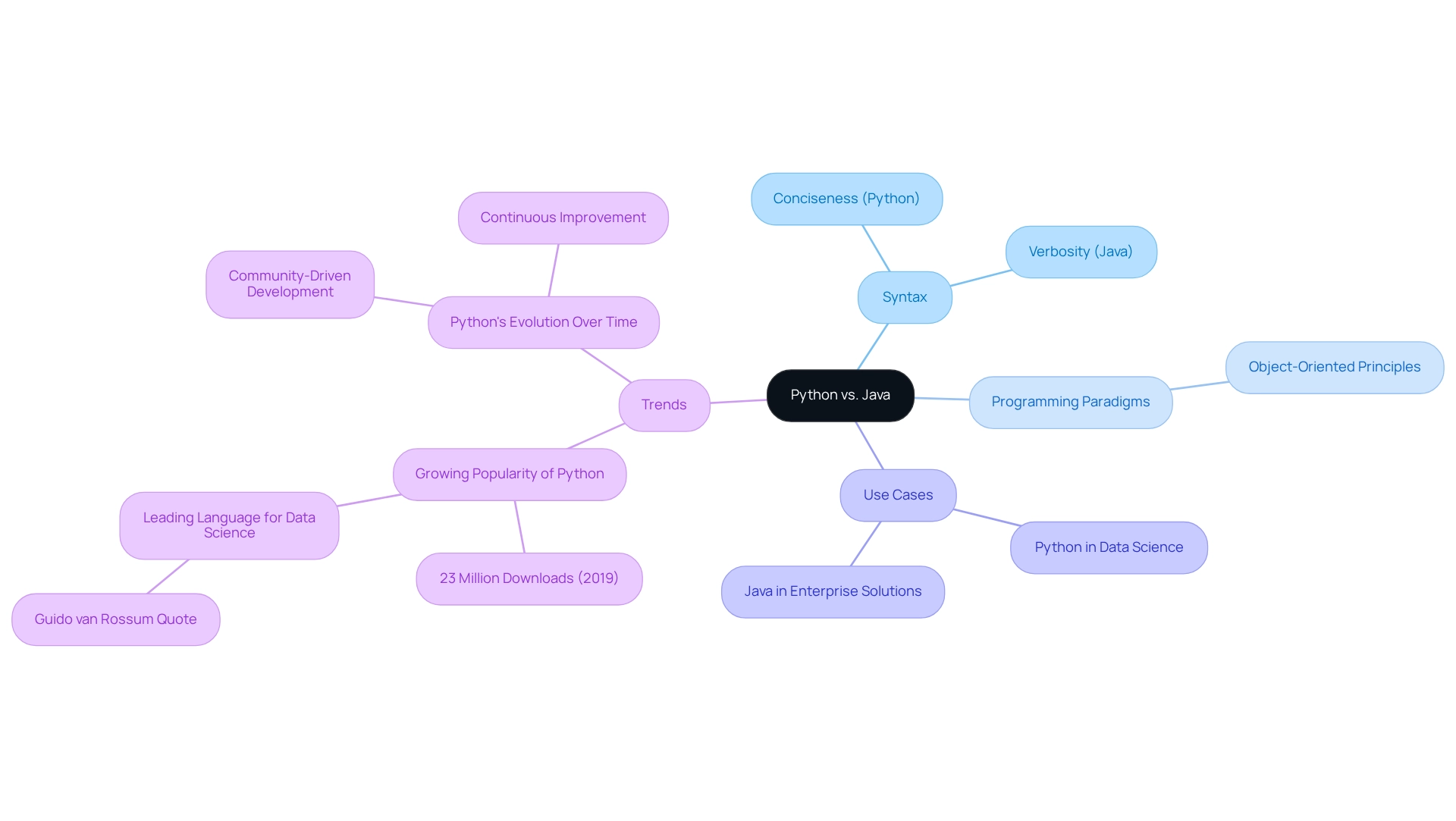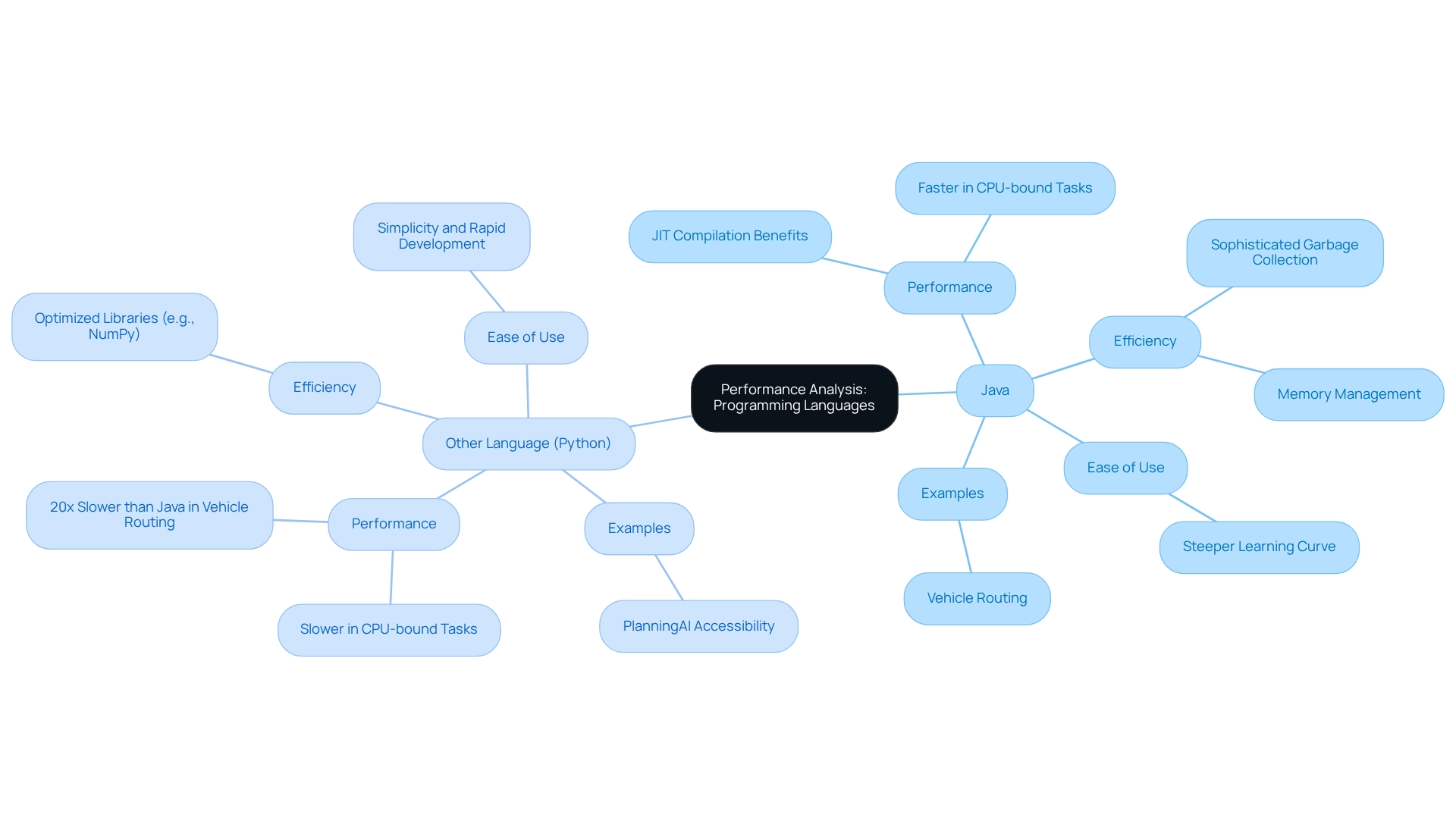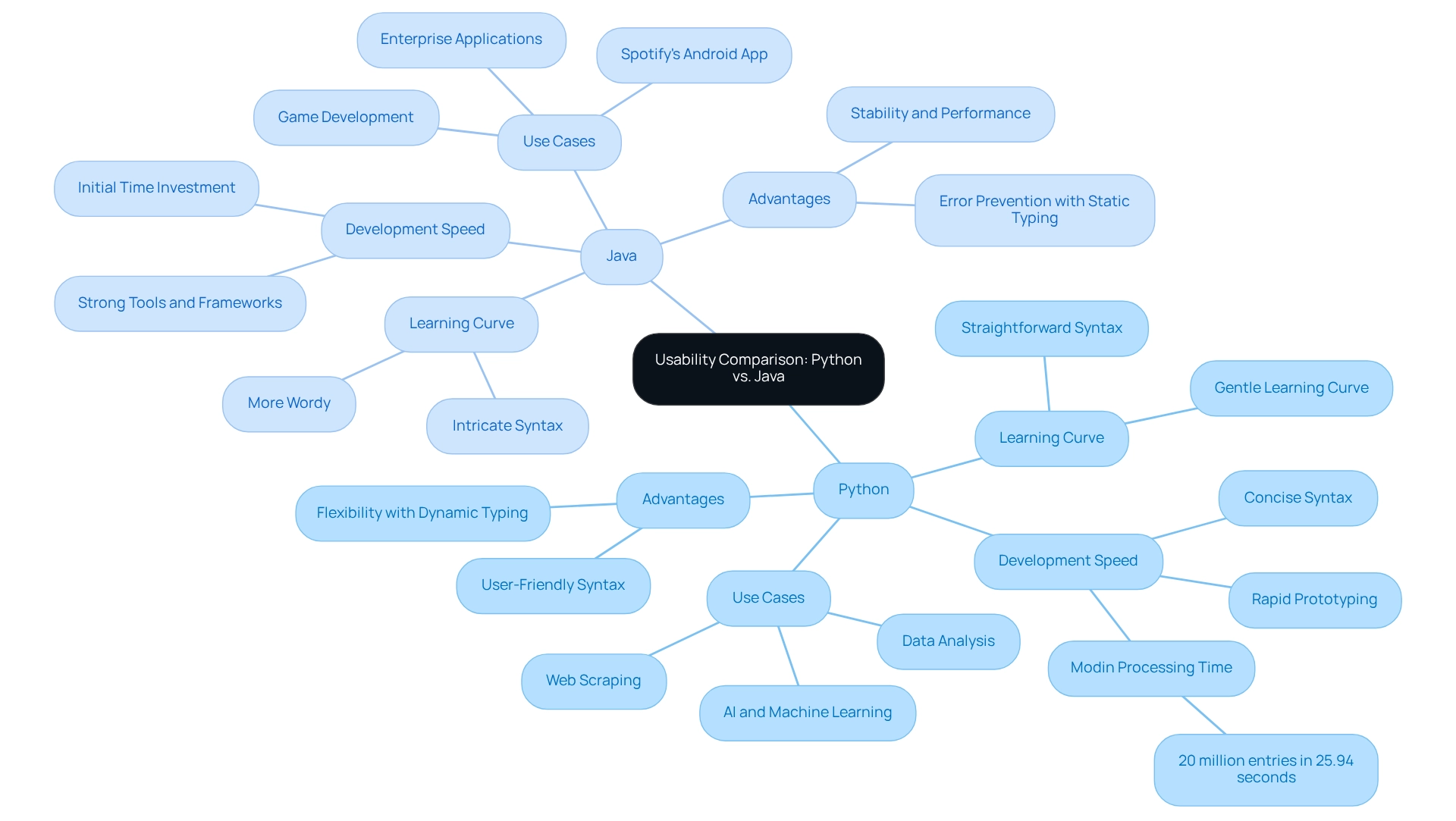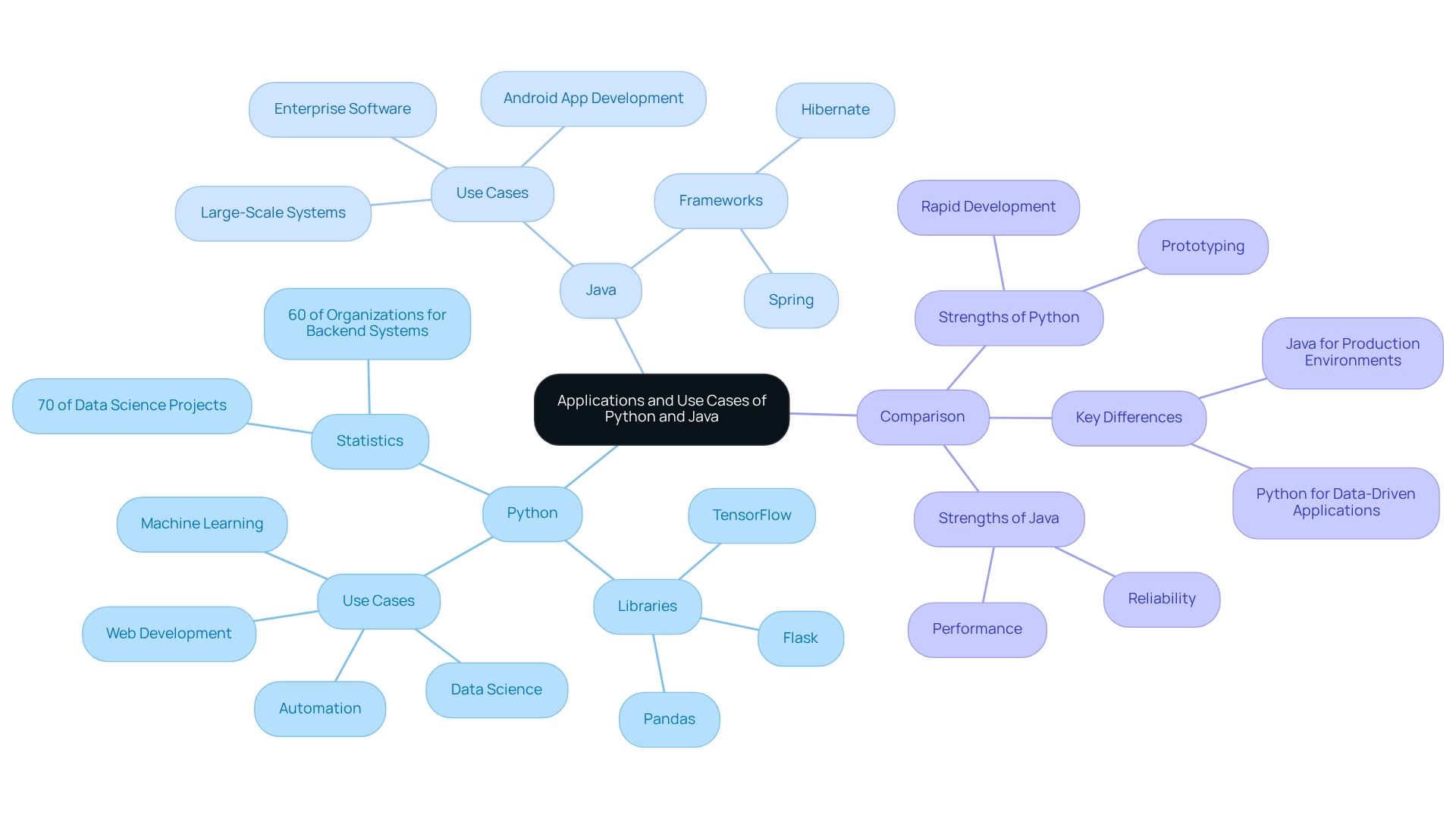Overview
The coding landscape presents numerous challenges for developers, particularly when choosing the right programming language. In this context, Python and Java emerge as two prominent contenders, each with distinct strengths. Python is often favored for its rapid development capabilities and ease of learning, making it an excellent choice for newcomers and projects requiring quick turnaround times. Conversely, Java shines in performance and stability, especially in enterprise applications that demand reliability and scalability.
Furthermore, the differences in syntax between the two languages play a significant role in their usability. Python's straightforward syntax allows developers to write less code, which can lead to faster development speeds. In contrast, Java's more verbose syntax can contribute to a steeper learning curve but offers robust features that are crucial for large-scale systems. This distinction highlights the specific use cases where each language excels, with Python dominating the data science field and Java being a preferred choice for enterprise-level applications.
In addition, understanding these nuances can help developers make informed decisions about which language to adopt for their projects. Are you looking for speed and simplicity, or do you require the performance and stability that Java provides? By reflecting on your coding practices and project requirements, you can better align your choice of programming language with your goals. Exploring the strengths of both Python and Java will ultimately enhance your coding efficiency and project outcomes.
Introduction
In the ever-evolving landscape of programming languages, developers often face challenges in selecting the right tools for their projects. Python and Java emerge as two of the most influential players, each carving out its own niche in the tech ecosystem.
Python has gained immense popularity for its simplicity and versatility, making it a go-to choice for:
- Data science
- Machine learning
- Rapid application development
Its user-friendly syntax allows newcomers to dive into coding with ease, fostering a vibrant community of developers.
In addition, Java maintains its stronghold in:
- Enterprise solutions
- Android app development
It is prized for its performance, scalability, and robust libraries. As organizations increasingly seek to harness the power of technology, understanding the distinct characteristics, performance metrics, and ideal use cases of these two languages becomes essential for developers aiming to make informed decisions in their projects.
This exploration delves into the key features, advantages, and applications of Python and Java, highlighting how each language can uniquely contribute to the success of modern software development.
Overview of Python and Java: Key Characteristics
In the realm of programming, developers often face significant challenges, particularly when it comes to maintaining code quality and productivity. Python, an interpreted, high-level programming system, is renowned for its clear syntax and dynamic typing. This makes it especially attractive for newcomers and ideal for rapid software development. It accommodates multiple programming paradigms, including procedural, object-oriented, and functional programming, broadening its applicability across various domains. Similarly, Java, a compiled, statically typed language, prioritizes portability and performance, making it a staple in enterprise environments and Android app development.
In the Python and Java comparison, both languages share object-oriented principles, yet they diverge in syntax. In a Python and Java comparison, Python's syntax is usually more concise, enhancing readability and user-friendliness, whereas Java's syntax often appears more verbose, embodying its design philosophy that prioritizes explicitness and clarity. This difference can affect development speed and code maintainability, with Python often facilitating quicker iterations due to its simplicity.
Recent trends indicate a growing preference for Python, particularly in data science and machine learning, where its ease of learning and versatility shine. By March 2019, downloads of Python for Windows users exceeded 23 million, highlighting its popularity. As Guido van Rossum, the inventor of Python, noted, it has become the leading language for data science, showcasing its adaptability and relevance in a rapidly evolving tech landscape. This adaptability is further illustrated by Python's evolution over time, reflecting its commitment to enhancing user experience and ensuring it remains relevant. In the meantime, Python continues to prosper in enterprise solutions, showcasing its lasting robustness and dependability in large-scale projects.
Furthermore, with tools like Kodezi CLI, teams can auto-heal codebases in seconds, enhancing productivity and allowing developers to focus on writing efficient code in either language. Kodezi's capabilities support the growing trend of utilizing programming languages in various applications, making it an essential tool for modern developers. Are you ready to explore how Kodezi can transform your coding practices and boost your productivity? With Kodezi, you can streamline your workflow and improve code quality—an opportunity not to be missed.

Performance Analysis: Speed, Efficiency, and Resource Management
Developers often face significant coding challenges, particularly when it comes to performance and efficiency. One programming language usually excels over another due to its Just-In-Time (JIT) compilation, which greatly enhances bytecode execution. Recent benchmarks indicate that this language can be up to ten times quicker than others in specific scenarios, especially in CPU-bound tasks. For instance, in vehicle routing, it can operate approximately twenty times faster than Java, underscoring its performance advantages in particular applications. This performance edge is crucial for tasks requiring intensive computation. Conversely, interpreted languages often lag in speed, especially in computation-heavy environments.
Despite these performance challenges, this programming language remains a favorite among developers due to its simplicity and rapid development capabilities. Its extensive libraries, such as NumPy, utilize optimized C code, effectively mitigating some performance limitations in critical tasks. Furthermore, Java's sophisticated garbage collection and memory management systems enhance its efficiency, particularly in large-scale applications.
A significant case study underscores the accessibility of PlanningAI via this programming language, highlighting the need to address performance challenges for practical application. The Timefold Solver seeks to enhance the accessibility of planning AI by enabling model development in this programming language, despite inherent performance obstacles. By tackling these concerns, Timefold aims to expand the usability and acceptance of optimization solutions, showcasing the continuous development of the language in performance-sensitive areas.
As Douglas Adams humorously noted, "I love deadlines. I like the whooshing sound they make as they fly by," this sentiment resonates in the programming world, where performance and efficiency are often tied to meeting critical deadlines.
In summary, the Python and Java comparison reveals that while the JIT compilation of one language provides considerable performance benefits, the simplicity and robust libraries of another remain a convincing option for numerous developers, especially in situations where quick development is favored over sheer speed. In a Python and Java comparison, the advantages and disadvantages of both programming options can be summarized as follows:
- Java excels in performance and efficiency, making it suitable for resource-intensive applications.
- Another option offers simplicity and rapid development, appealing to developers who prioritize ease of use over performance.

Usability Comparison: Learning Curve and Development Speed
Coding can often present significant challenges for developers, particularly when it comes to learning new languages and managing complex projects. Python is frequently lauded for its gentle learning curve, making it an excellent choice for beginners. Its syntax is straightforward and closely resembles natural language, facilitating quick comprehension and coding. In contrast, Java's syntax is more intricate and wordy, posing difficulties for inexperienced developers. However, the robust typing and structured nature of Java can lead to fewer runtime errors, which is especially advantageous for larger teams and projects. As noted, "Java is solid for developing enterprise web systems, while Python is especially good for web scraping and scripting."
Furthermore, development speed tends to be quicker in Python due to its concise syntax and dynamic characteristics, enabling rapid prototyping. For instance, Python's Modin library processes twenty million entries in just 25.94 seconds, showcasing its efficiency in handling large datasets. In addition, although Java may initially demand more time for development, it provides strong tools and frameworks that can greatly improve productivity in larger applications. This makes Java a favored option for enterprise-level projects, as demonstrated by its application in Spotify's Android app and secure web backend.
With Kodezi, programmers can further enhance their productivity in both Python and Java. Kodezi's AI-powered tool automatically analyzes and corrects code, allowing developers to focus on building features rather than debugging. This capability is especially beneficial in Python's dynamic development environment and in Java, where organized coding can gain from Kodezi's bug analysis and optimization features. Kodezi differentiates itself from tools like Copilot by acting as an autocorrect for code rather than merely providing autocomplete suggestions.
Real-world examples demonstrate that Python excels in areas such as AI and data analysis, where its simplicity enables faster implementation of machine learning algorithms. Meanwhile, Java remains a staple in enterprise applications and game development, providing stability and performance. The dynamic typing in Python provides flexibility, whereas Java's static typing highlights error prevention and predictability.
Ultimately, both languages have distinct advantages. Python's user-friendly syntax aids development speed, making it ideal for quick projects, while Java's structured approach ensures reliability in complex systems. A structured Python and Java comparison reveals that while Python is advantageous for rapid development and ease of learning, Java excels in stability and enterprise-level applications. With Kodezi, users can utilize AI to optimize their coding procedures in both systems, boosting overall productivity. Kodezi currently supports over 30 programming languages and is designed to work seamlessly with Visual Studio Code, with plans to support more IDEs in the future.

Applications and Use Cases: Where Python and Java Shine
In the ever-evolving landscape of programming, one language stands out for its exceptional capabilities in data science, machine learning, web development, and automation. This programming language boasts a rich ecosystem of libraries and frameworks, including:
- Pandas
- TensorFlow
- Flask
These significantly contribute to its versatility. As a result, it has become a favored choice among startups and researchers, particularly in 2025, where its role in data science and machine learning is increasingly prominent. Recent statistics reveal that Python is utilized in over 70% of data science projects, underscoring its dominance in this field.
Furthermore, this programming language maintains its leadership in:
- Enterprise software
- Android app development
- Large-scale systems
Its performance, scalability, and robust ecosystem make it ideal for developing secure and maintainable software. Notably, its adaptability was demonstrated through real-time updates for SecuTix’s ticketing system integration, showcasing its effectiveness in enterprise settings. Frameworks such as Spring and Hibernate significantly enhance the language's capabilities, enabling developers to create complex applications that meet enterprise-level demands. In 2025, this programming language continues to be a top choice for enterprise solutions, with approximately 60% of organizations relying on it for their backend systems.
In a Python and Java comparison, both languages serve distinct niches: one is preferred for rapid development and prototyping, allowing developers to quickly iterate on ideas, while the other is often selected for its reliability and performance in production environments. As David Sides aptly puts it, "Data is like a faint light when you're lost in a dark room. Follow it, try to make sense of it, and you might actually know where you are and what's around you." This perspective highlights the importance of data in programming, particularly in the realms of data science and machine learning. Real-world examples illustrate this difference; for instance, companies like Netflix utilize this programming language for their backend services due to its strength, while many startups opt for another language for data-driven applications and machine learning models. Moreover, a Python and Java comparison illustrates that Java remains a popular choice in 2025, effectively competing with other programming options like JavaScript and Kotlin. As the tech landscape continues to evolve, both languages will play crucial roles in their respective domains.

Conclusion
The choice between Python and Java presents developers with significant considerations, as both languages address distinct challenges in software development. Python's simplicity and user-friendly syntax make it an attractive option for those embarking on their coding journey or needing to develop applications swiftly, particularly in the realms of data science and machine learning. With Python dominating over 70% of data science projects, its relevance in today’s tech landscape is undeniable.
In contrast, Java’s robust performance and scalability establish it as a cornerstone in enterprise solutions and Android app development. The language’s powerful libraries and frameworks, such as Spring and Hibernate, enable developers to create secure, maintainable applications capable of managing extensive operations. Furthermore, Java’s ability to deliver real-time updates in enterprise applications underscores its reliability, making it a favored choice among organizations.
Ultimately, the decision between Python and Java depends on the specific needs of a project. While Python is ideal for scenarios that prioritize rapid development and ease of use, Java shines in environments where performance and stability are paramount. As technology continues to evolve, both languages will remain essential, each uniquely contributing to the success of modern software development. By understanding their strengths and appropriate use cases, developers can make informed choices that drive innovation and efficiency in their projects.
Frequently Asked Questions
What are the main challenges developers face in programming?
Developers often face significant challenges related to maintaining code quality and productivity.
What are the key features of Python as a programming language?
Python is an interpreted, high-level programming language known for its clear syntax and dynamic typing, making it attractive for newcomers and ideal for rapid software development. It supports multiple programming paradigms, including procedural, object-oriented, and functional programming.
How does Java differ from Python?
Java is a compiled, statically typed language that prioritizes portability and performance, making it a staple in enterprise environments and Android app development. While both languages share object-oriented principles, their syntax differs; Python's syntax is usually more concise, enhancing readability, whereas Java's syntax is often more verbose.
What impact does the syntax of Python and Java have on development?
The differences in syntax can affect development speed and code maintainability, with Python often allowing for quicker iterations due to its simplicity compared to Java's more explicit and clear design.
Why is Python becoming increasingly popular in recent years?
Python's popularity is growing, particularly in data science and machine learning, due to its ease of learning and versatility. By March 2019, downloads of Python for Windows users exceeded 23 million, highlighting its widespread use.
What role does Kodezi CLI play in programming?
Kodezi CLI helps teams auto-heal codebases in seconds, enhancing productivity and allowing developers to focus on writing efficient code in either Python or Java. It supports the trend of utilizing programming languages in various applications, making it an essential tool for modern developers.
How has Python evolved over time?
Python has evolved to enhance user experience and maintain its relevance in a rapidly changing tech landscape, showcasing its adaptability. It continues to be robust and dependable for enterprise solutions and large-scale projects.




